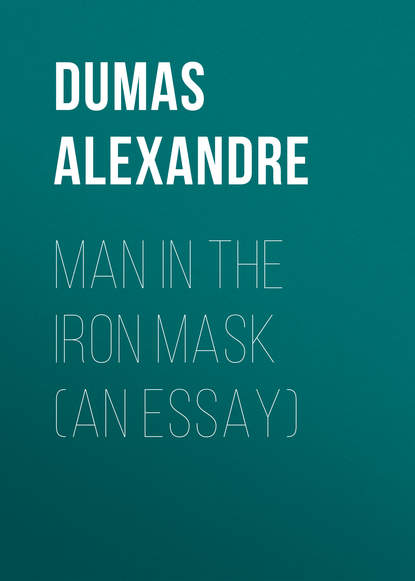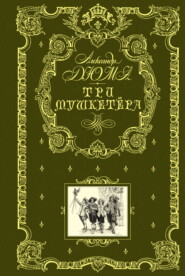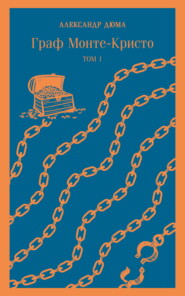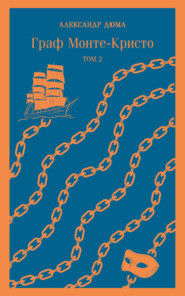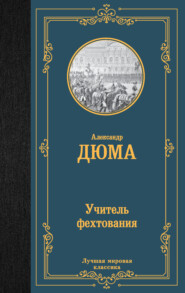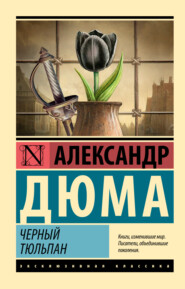По всем вопросам обращайтесь на: info@litportal.ru
(©) 2003-2024.
✖
Man in the Iron Mask (an Essay)
Настройки чтения
Размер шрифта
Высота строк
Поля
“In the first volume of the ‘Histoire de la Detention des Philosophes et des Gens de Lettres a la Bastille, etc.’, we find the following passage: —
“Without dwelling on the difficulty and danger of an abduction, which an Ottoman scimitar might any day during this memorable siege render unnecessary, we shall restrict ourselves to declaring positively that the correspondence of Saint-Mars from 1669 to 1680 gives us no ground for supposing that the governor of Pignerol had any great prisoner of state in his charge during that period of time, except Fouquet and Lauzun.’”
While we profess no blind faith in the conclusions arrived at by the learned critic, we would yet add to the considerations on which he relies another, viz. that it is most improbable that Louis XIV should ever have considered it necessary to take such rigorous measures against the Duc de Beaufort. Truculent and self-confident as he was, he never acted against the royal authority in such a manner as to oblige the king to strike him down in secret; and it is difficult to believe that Louis XIV, peaceably seated on his throne, with all the enemies of his minority under his feet, should have revenged himself on the duke as an old Frondeur.
The critic calls our attention to another fact also adverse to the theory under consideration. The Man in the Iron Mask loved fine linen and rich lace, he was reserved in character and possessed of extreme refinement, and none of this suits the portraits of the ‘roi des halles’ which contemporary historians have drawn.
Regarding the anagram of the name Marchiali (the name under which the death of the prisoner was registered), ‘hic amiral’, as a proof, we cannot think that the gaolers of Pignerol amused themselves in propounding conundrums to exercise the keen intellect of their contemporaries; and moreover the same anagram would apply equally well to the Count of Vermandois, who was made admiral when only twenty-two months old. Abbe Papon, in his roamings through Provence, paid a visit to the prison in which the Iron Mask was confined, and thus speaks: —
“It was to the Iles Sainte-Marguerite that the famous prisoner with the iron mask whose name has never been discovered, was transported at the end of the last century; very few of those attached to his service were allowed to speak to him. One day, as M. de Saint-Mars was conversing with him, standing outside his door, in a kind of corridor, so as to be able to see from a distance everyone who approached, the son of one of the governor’s friends, hearing the voices, came up; Saint-Mars quickly closed the door of the room, and, rushing to meet the young man, asked him with an air of great anxiety if he had overheard anything that was said. Having convinced himself that he had heard nothing, the governor sent the young man away the same day, and wrote to the father that the adventure was like to have cost the son dear, and that he had sent him back to his home to prevent any further imprudence.
“I was curious enough to visit the room in which the unfortunate man was imprisoned, on the 2nd of February 1778. It is lighted by one window to the north, overlooking the sea, about fifteen feet above the terrace where the sentries paced to and fro. This window was pierced through a very thick wall and the embrasure barricaded by three iron bars, thus separating the prisoner from the sentries by a distance of over two fathoms. I found an officer of the Free Company in the fortress who was nigh on fourscore years old; he told me that his father, who had belonged to the same Company, had often related to him how a friar had seen something white floating on the water under the prisoner’s window. On being fished out and carried to M. de Saint-Mars, it proved to be a shirt of very fine material, loosely folded together, and covered with writing from end to end. M. de Saint-Mars spread it out and read a few words, then turning to the friar who had brought it he asked him in an embarrassed manner if he had been led by curiosity to read any of the, writing. The friar protested repeatedly that he had not read a line, but nevertheless he was found dead in bed two days later. This incident was told so often to my informant by his father and by the chaplain of the fort of that time that he regarded it as incontestably true. The following fact also appears to me to be equally well established by the testimony of many witnesses. I collected all the evidence I could on the spot, and also in the Lerins monastery, where the tradition is preserved.
“A female attendant being wanted for the prisoner, a woman of the village of Mongin offered herself for the place, being under the impression that she would thus be able to make her children’s fortune; but on being told that she would not only never be allowed to see her children again, but would be cut off from the rest of the world as well, she refused to be shut up with a prisoner whom it cost so much to serve. I may mention here that at the two outer angles of the wall of the fort which faced the sea two sentries were placed, with orders to fire on any boat which approached within a certain distance.
“The prisoner’s personal attendant died in the Iles Sainte-Marguerite. The brother of the officer whom I mentioned above was partly in the confidence of M. de Saint-Mars, and he often told how he was summoned to the prison once at midnight and ordered to remove a corpse, and that he carried it on his shoulders to the burial-place, feeling certain it was the prisoner who was dead; but it was only his servant, and it was then that an effort was made to supply his place by a female attendant.”
Abbe Papon gives some curious details, hitherto unknown to the public, but as he mentions no names his narrative cannot be considered as evidence. Voltaire never replied to Lagrange-Chancel, who died the same year in which his letter was published. Freron desiring to revenge himself for the scathing portrait which Voltaire had drawn of him in the ‘Ecossaise’, called to his assistance a more redoubtable adversary than Lagrange-Chancel. Sainte-Foix had brought to the front a brand new theory, founded on a passage by Hume in an article in the ‘Annee Litteraire (1768, vol. iv.), in which he maintained that the Man in the Iron Mask was the Duke of Monmouth, a natural son of Charles II, who was found guilty of high treason and beheaded in London on the 15th July 1685.
This is what the English historian says:
“It was commonly reported in London that the Duke of Monmouth’s life had been saved, one of his adherents who bore a striking resemblance to the duke having consented to die in his stead, while the real culprit was secretly carried off to France, there to undergo a lifelong imprisonment.”
The great affection which the English felt for the Duke of Monmouth, and his own conviction that the people only needed a leader to induce them to shake off the yoke of James II, led him to undertake an enterprise which might possibly have succeeded had it been carried out with prudence. He landed at Lyme, in Dorset, with only one hundred and twenty men; six thousand soon gathered round his standard; a few towns declared in his favour; he caused himself to be proclaimed king, affirming that he was born in wedlock, and that he possessed the proofs of the secret marriage of Charles II and Lucy Waiters, his mother. He met the Royalists on the battlefield, and victory seemed to be on his side, when just at the decisive moment his ammunition ran short. Lord Gray, who commanded the cavalry, beat a cowardly retreat, the unfortunate Monmouth was taken prisoner, brought to London, and beheaded.
The details published in the ‘Siecle de Louis XIV’ as to the personal appearance of the masked prisoner might have been taken as a description of Monmouth, who possessed great physical beauty. Sainte-Foix had collected every scrap of evidence in favour of his solution of the mystery, making use even of the following passage from an anonymous romance called ‘The Loves of Charles II and James II, Kings of England’: —
“The night of the pretended execution of the Duke of Monmouth, the king, attended by three men, came to the Tower and summoned the duke to his presence. A kind of loose cowl was thrown over his head, and he was put into a carriage, into which the king and his attendants also got, and was driven away.”
Sainte-Foix also referred to the alleged visit of Saunders, confessor to James II, paid to the Duchess of Portsmouth after the death of that monarch, when the duchess took occasion to say that she could never forgive King James for consenting to Monmouth’s execution, in spite of the oath he had taken on the sacred elements at the deathbed of Charles II that he would never take his natural brother’s life, even in case of rebellion. To this the priest replied quickly, “The king kept his oath.”
Hume also records this solemn oath, but we cannot say that all the historians agree on this point. ‘The Universal History’ by Guthrie and Gray, and the ‘Histoire d’Angleterre’ by Rapin, Thoyras and de Barrow, do not mention it.
“Further,” wrote Sainte-Foix, “an English surgeon called Nelaton, who frequented the Cafe Procope, much affected by men of letters, often related that during the time he was senior apprentice to a surgeon who lived near the Porte Saint-Antoine, he was once taken to the Bastille to bleed a prisoner. He was conducted to this prisoner’s room by the governor himself, and found the patient suffering from violent headache. He spoke with an English accent, wore a gold-flowered dressing-gown of black and orange, and had his face covered by a napkin knotted behind his head.”
This story does not hold water: it would be difficult to form a mask out of a napkin; the Bastille had a resident surgeon of its own as well as a physician and apothecary; no one could gain access to a prisoner without a written order from a minister, even the Viaticum could only be introduced by the express permission of the lieutenant of police.
This theory met at first with no objections, and seemed to be going to oust all the others, thanks, perhaps, to the combative and restive character of its promulgator, who bore criticism badly, and whom no one cared to incense, his sword being even more redoubtable than his pen.
It was known that when Saint-Mars journeyed with his prisoner to the Bastille, they had put up on the way at Palteau, in Champagne, a property belonging to the governor. Freron therefore addressed himself to a grand-nephew of Saint-Mars, who had inherited this estate, asking if he could give him any information about this visit. The following reply appeared in the ‘Annee Litteraire (June 1768): —
“As it appears from the letter of M. de Sainte-Foix from which you quote that the Man in the Iron Mask still exercises the fancy of your journalists, I am willing to tell you all I know about the prisoner. He was known in the islands of Sainte-Marguerite and at the Bastille as ‘La Tour.’ The governor and all the other officials showed him great respect, and supplied him with everything he asked for that could be granted to a prisoner. He often took exercise in the yard of the prison, but never without his mask on. It was not till the ‘Siecle’ of M. de Voltaire appeared that I learned that the mask was of iron and furnished with springs; it may be that the circumstance was overlooked, but he never wore it except when taking the air, or when he had to appear before a stranger.
“M. de Blainvilliers, an infantry officer who was acquainted with M. de Saint-Mars both at Pignerol and Sainte-Marguerite, has often told me that the lot of ‘La Tour’ greatly excited his curiosity, and that he had once borrowed the clothes and arms of a soldier whose turn it was to be sentry on the terrace under the prisoner’s window at Sainte-Marguerite, and undertaken the duty himself; that he had seen the prisoner distinctly, without his mask; that his face was white, that he was tall and well proportioned, except that his ankles were too thick, and that his hair was white, although he appeared to be still in the prime of life. He passed the whole of the night in question pacing to and fro in his room. Blainvilliers added that he was always dressed in brown, that he had plenty of fine linen and books, that the governor and the other officers always stood uncovered in his presence till he gave them leave to cover and sit down, and that they often bore him company at table.
“In 1698 M. de Saint-Mars was promoted from the governorship of the Iles Sainte-Marguerite to that of the Bastille. In moving thither, accompanied by his prisoner, he made his estate of Palteau a halting-place. The masked man arrived in a litter which preceded that of M. de Saint-Mars, and several mounted men rode beside it. The peasants were assembled to greet their liege lord. M. de Saint-Mars dined with his prisoner, who sat with his back to the dining-room windows, which looked out on the court. None of the peasants whom I have questioned were able to see whether the man kept his mask on while eating, but they all noticed that M. de Saint-Mars, who sat opposite to his charge, laid two pistols beside his plate; that only one footman waited at table, who went into the antechamber to change the plates and dishes, always carefully closing the dining-room door behind him. When the prisoner crossed the courtyard his face was covered with a black mask, but the peasants could see his lips and teeth, and remarked that he was tall, and had white hair. M. de Saint-Mars slept in a bed placed beside the prisoner’s. M. de Blainvilliers told me also that ‘as soon as he was dead, which happened in 1704, he was buried at Saint-Paul’s,’ and that ‘the coffin was filled with substances which would rapidly consume the body.’ He added, ‘I never heard that the masked man spoke with an English accent.’”
Sainte-Foix proved the story related by M. de Blainvilliers to be little worthy of belief, showing by a circumstance mentioned in the letter that the imprisoned man could not be the Duc de Beaufort; witness the epigram of Madame de Choisy, “M. de Beaufort longs to bite and can’t,” whereas the peasants had seen the prisoner’s teeth through his mask. It appeared as if the theory of Sainte-Foix were going to stand, when a Jesuit father, named Griffet, who was confessor at the Bastille, devoted chapter xiii, of his ‘Traite des differentes Sortes de Preuves qui servent a etablir la Verite dans l’Histoire’ (12mo, Liege, 1769) to the consideration of the Iron Mask. He was the first to quote an authentic document which certifies that the Man in the Iron Mask about whom there was so much disputing really existed. This was the written journal of M. du Jonca, King’s Lieutenant in the Bastille in 1698, from which Pere Griffet took the following passage: —
“On Thursday, September the 8th, 1698, at three o’clock in the afternoon, M. de Saint-Mars, the new governor of the Bastille, entered upon his duties. He arrived from the islands of Sainte-Marguerite, bringing with him in a litter a prisoner whose name is a secret, and whom he had had under his charge there, and at Pignerol. This prisoner, who was always masked, was at first placed in the Bassiniere tower, where he remained until the evening. At nine o’clock p.m. I took him to the third room of the Bertaudiere tower, which I had had already furnished before his arrival with all needful articles, having received orders to do so from M. de Saint-Mars. While I was showing him the way to his room, I was accompanied by M. Rosarges, who had also arrived along with M. de Saint-Mars, and whose office it was to wait on the said prisoner, whose table is to be supplied by the governor.”
Du Jonca’s diary records the death of the prisoner in the following terms: —
“Monday, 19th November 1703. The unknown prisoner, who always wore a black velvet mask, and whom M. de Saint-Mars brought with him from the Iles Sainte-Marguerite, and whom he had so long in charge, felt slightly unwell yesterday on coming back from mass. He died to-day at 10 p.m. without having a serious illness, indeed it could not have been slighter. M. Guiraut, our chaplain, confessed him yesterday, but as his death was quite unexpected he did not receive the last sacraments, although the chaplain was able to exhort him up to the moment of his death. He was buried on Tuesday the 20th November at 4 P.M. in the burial-ground of St. Paul’s, our parish church. The funeral expenses amounted to 40 livres.”
His name and age were withheld from the priests of the parish. The entry made in the parish register, which Pere Griffet also gives, is in the following words: —
“On the 19th November 1703, Marchiali, aged about forty-five, died in the Bastille, whose body was buried in the graveyard of Saint-Paul’s, his parish, on the 20th instant, in the presence of M. Rosarges and of M. Reilh, Surgeon-Major of the Bastille.
“(Signed) ROSARGES.
“REILH.”
As soon as he was dead everything belonging to him, without exception, was burned; such as his linen, clothes, bed and bedding, rugs, chairs, and even the doors of the room he occupied. His service of plate was melted down, the walls of his room were scoured and whitewashed, the very floor was renewed, from fear of his having hidden a note under it, or left some mark by which he could be recognised.
Pere Griffet did not agree with the opinions of either Lagrange-Chancel or Sainte-Foix, but seemed to incline towards the theory set forth in the ‘Memoires de Perse’, against which no irrefutable objections had been advanced. He concluded by saying that before arriving at any decision as to who the prisoner really was, it would be necessary to ascertain the exact date of his arrival at Pignerol.
Sainte-Foix hastened to reply, upholding the soundness of the views he had advanced. He procured from Arras a copy of an entry in the registers of the Cathedral Chapter, stating that Louis XIV had written with his own hand to the said Chapter that they were to admit to burial the body of the Comte de Vermandois, who had died in the city of Courtrai; that he desired that the deceased should be interred in the centre of the choir, in the vault in which lay the remains of Elisabeth, Comtesse de Vermandois, wife of Philip of Alsace, Comte de Flanders, who had died in 1182. It is not to be supposed that Louis XIV would have chosen a family vault in which to bury a log of wood.
Sainte-Foix was, however, not acquainted with the letter of Barbezieux, dated the 13th August 1691, to which we have already referred, as a proof that the prisoner was not the Comte de Vermandois; it is equally a proof that he was not the Duke of Monmouth, as Sainte-Foix maintained; for sentence was passed on the Duke of Monmouth in 1685, so that it could not be of him either that Barbezieux wrote in 1691, “The prisoner whom you have had in charge for twenty years.”
In the very year in which Sainte-Foix began to flatter himself that his theory was successfully established, Baron Heiss brought a new one forward, in a letter dated “Phalsburg, 28th June 1770,” and addressed to the ‘Journal Enclycopedique’. It was accompanied by a letter translated from the Italian which appeared in the ‘Histoire Abregee de l’Europe’ by Jacques Bernard, published by Claude Jordan, Leyden, 1685-87, in detached sheets. This letter stated (August 1687, article ‘Mantoue’) that the Duke of Mantua being desirous to sell his capital, Casale, to the King of France, had been dissuaded therefrom by his secretary, and induced to join the other princes of Italy in their endeavours to thwart the ambitious schemes of Louis XVI. The Marquis d’Arcy, French ambassador to the court of Savoy, having been informed of the secretary’s influence, distinguished him by all kinds of civilities, asked him frequently to table, and at last invited him to join a large hunting party two or three leagues outside Turin. They set out together, but at a short distance from the city were surrounded by a dozen horsemen, who carried off the secretary, ‘disguised him, put a mask on him, and took him to Pignerol.’ He was not kept long in this fortress, as it was ‘too near the Italian frontier, and although he was carefully guarded it was feared that the walls would speak’; so he was transferred to the Iles Sainte-Marguerite, where he is at present in the custody of M. de Saint-Mars.
This theory, of which much was heard later, did not at first excite much attention. What is certain is that the Duke of Mantua’s secretary, by name Matthioli, was arrested in 1679 through the agency of Abbe d’Estrade and M. de Catinat, and taken with the utmost secrecy to Pignerol, where he was imprisoned and placed in charge of M. de Saint-Mars. He must not, however, be confounded with the Man in the Iron Mask.
Catinat says of Matthioli in a letter to Louvois “No one knows the name of this knave.”
Louvois writes to Saint-Mars: “I admire your patience in waiting for an order to treat such a rogue as he deserves, when he treats you with disrespect.”
Saint-Mars replies to the minister: “I have charged Blainvilliers to show him a cudgel and tell him that with its aid we can make the froward meek.”
Again Louvois writes: “The clothes of such people must be made to last three or four years.”
This cannot have been the nameless prisoner who was treated with such consideration, before whom Louvois stood bare-headed, who was supplied with fine linen and lace, and so on.
Altogether, we gather from the correspondence of Saint-Mars that the unhappy man alluded to above was confined along with a mad Jacobin, and at last became mad himself, and succumbed to his misery in 1686.
Voltaire, who was probably the first to supply such inexhaustible food for controversy, kept silence and took no part in the discussions. But when all the theories had been presented to the public, he set about refuting them. He made himself very merry, in the seventh edition of ‘Questions sur l’Encyclopedie distibuees en forme de Dictionnaire (Geneva, 1791), over the complaisance attributed to Louis XIV in acting as police-sergeant and gaoler for James II, William III, and Anne, with all of whom he was at war. Persisting still in taking 1661 or 1662 as the date when the incarceration of the masked prisoner began, he attacks the opinions advanced by Lagrange-Chancel and Pere Griffet, which they had drawn from the anonymous ‘Memoires secrets pour servir a l’Histoire de Perse’. “Having thus dissipated all these illusions,” he says, “let us now consider who the masked prisoner was, and how old he was when he died. It is evident that if he was never allowed to walk in the courtyard of the Bastille or to see a physician without his mask, it must have been lest his too striking resemblance to someone should be remarked; he could show his tongue but not his face. As regards his age, he himself told the apothecary at the Bastille, a few days before his death, that he thought he was about sixty; this I have often heard from a son-in-law to this apothecary, M. Marsoban, surgeon to Marshal Richelieu, and afterwards to the regent, the Duc d’Orleans. The writer of this article knows perhaps more on this subject than Pere Griffet. But he has said his say.”
This article in the ‘Questions on the Encyclopaedia’ was followed by some remarks from the pen of the publisher, which are also, however, attributed by the publishers of Kelh to Voltaire himself. The publisher, who sometimes calls himself the author, puts aside without refutation all the theories advanced, including that of Baron Heiss, and says he has come to the conclusion that the Iron Mask was, without doubt, a brother and an elder brother of Louis XIV, by a lover of the queen. Anne of Austria had come to persuade herself that hers alone was the fault which had deprived Louis XIII [the publisher of this edition overlooked the obvious typographical error of “XIV” here when he meant, and it only makes sense, that it was XIII. D.W.] of an heir, but the birth of the Iron Mask undeceived her. The cardinal, to whom she confided her secret, cleverly arranged to bring the king and queen, who had long lived apart, together again. A second son was the result of this reconciliation; and the first child being removed in secret, Louis XIV remained in ignorance of the existence of his half-brother till after his majority. It was the policy of Louis XIV to affect a great respect for the royal house, so he avoided much embarrassment to himself and a scandal affecting the memory of Anne of Austria by adopting the wise and just measure of burying alive the pledge of an adulterous love. He was thus enabled to avoid committing an act of cruelty, which a sovereign less conscientious and less magnanimous would have considered a necessity.
After this declaration Voltaire made no further reference to the Iron Mask. This last version of the story upset that of Sainte-Foix. Voltaire having been initiated into the state secret by the Marquis de Richelieu, we may be permitted to suspect that being naturally indiscreet he published the truth from behind the shelter of a pseudonym, or at least gave a version which approached the truth, but later on realising the dangerous significance of his words, he preserved for the future complete silence.
We now approach the question whether the prince who thus became the Iron Mask was an illegitimate brother or a twin-brother of Louis XIV. The first was maintained by M. Quentin-Crawfurd; the second by Abbe Soulavie in his ‘Memoires du Marechal Duc de Richelieu’ (London, 1790). In 1783 the Marquis de Luchet, in the ‘Journal des Gens du Monde’ (vol. iv. No. 23, p. 282, et seq.), awarded to Buckingham the honour of the paternity in dispute. In support of this, he quoted the testimony of a lady of the house of Saint-Quentin who had been a mistress of the minister Barbezieux, and who died at Chartres about the middle of the eighteenth century. She had declared publicly that Louis XIV had consigned his elder brother to perpetual imprisonment, and that the mask was necessitated by the close resemblance of the two brothers to each other.
The Duke of Buckingham, who came to France in 1625, in order to escort Henrietta Maria, sister of Louis XIII, to England, where she was to marry the Prince of Wales, made no secret of his ardent love for the queen, and it is almost certain that she was not insensible to his passion. An anonymous pamphlet, ‘La Conference du Cardinal Mazarin avec le Gazetier’ (Brussels, 1649), says that she was infatuated about him, and allowed him to visit her in her room. She even permitted him to take off and keep one of her gloves, and his vanity leading him to show his spoil, the king heard of it, and was vastly offended. An anecdote, the truth of which no one has ever denied, relates that one day Buckingham spoke to the queen with such passion in the presence of her lady-in-waiting, the Marquise de Senecey, that the latter exclaimed, “Be silent, sir, you cannot speak thus to the Queen of France!” According to this version, the Man in the Iron Mask must have been born at latest in 1637, but the mention of any such date would destroy the possibility of Buckingham’s paternity; for he was assassinated at Portsmouth on September 2nd, 1628.
After the taking of the Bastille the masked prisoner became the fashionable topic of discussion, and one heard of nothing else. On the 13th of August 1789 it was announced in an article in a journal called ‘Loisirs d’un Patriote francais’, which was afterwards published anonymously as a pamphlet, that the publisher had seen, among other documents found in the Bastille, a card bearing the unintelligible number “64389000,” and the following note: “Fouquet, arriving from Les Iles Sainte-Marguerite in an iron mask.” To this there was, it was said, a double signature, viz. “XXX,” superimposed on the name “Kersadion.” The journalist was of opinion that Fouquet had succeeded in making his escape, but had been retaken and condemned to pass for dead, and to wear a mask henceforward, as a punishment for his attempted evasion. This tale made some impression, for it was remembered that in the Supplement to the ‘Siecle de Louis XIV’ it was stated that Chamillart had said that “the Iron Mask was a man who knew all the secrets of M. Fouquet.” But the existence of this card was never proved, and we cannot accept the story on the unsupported word of an anonymous writer.





